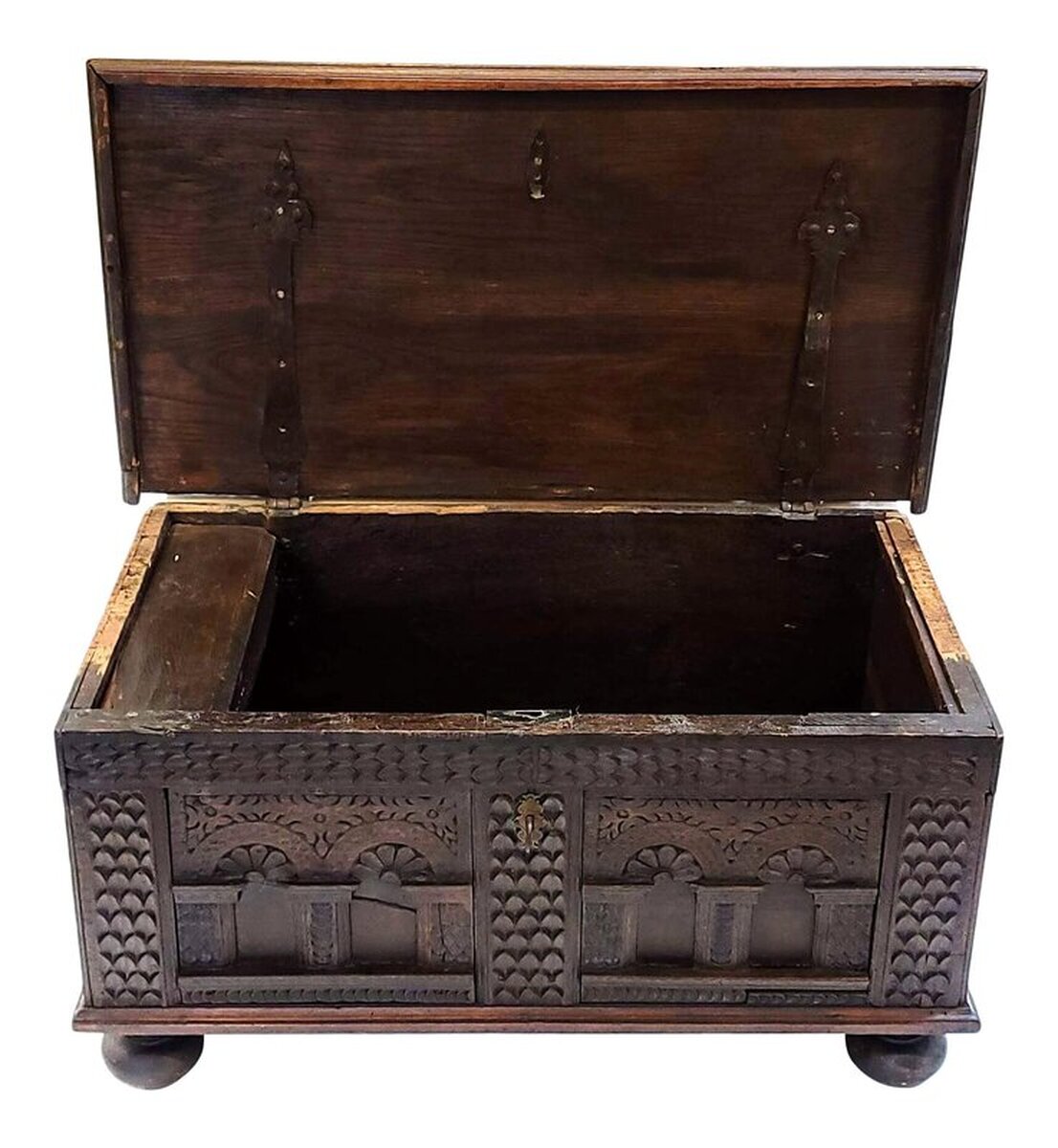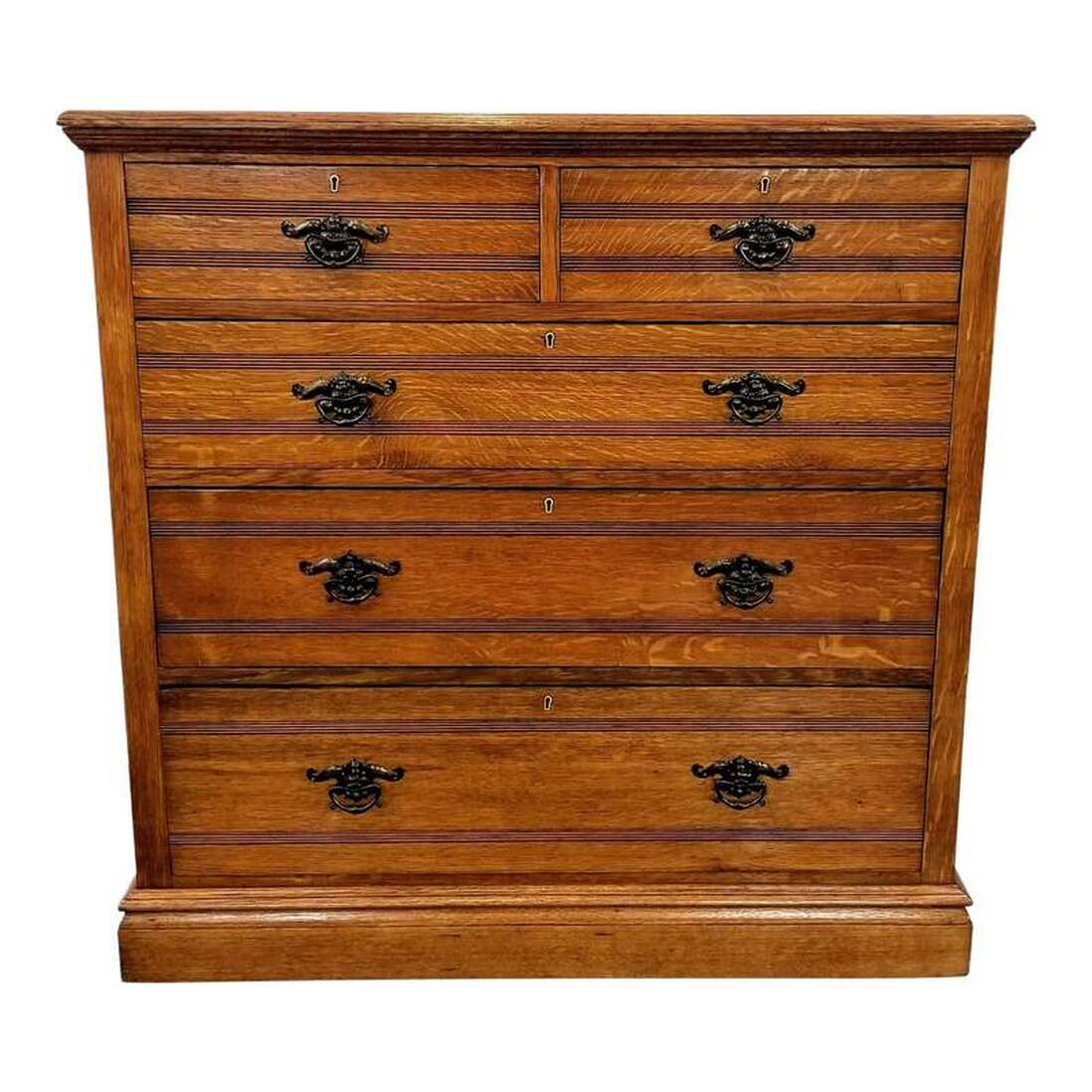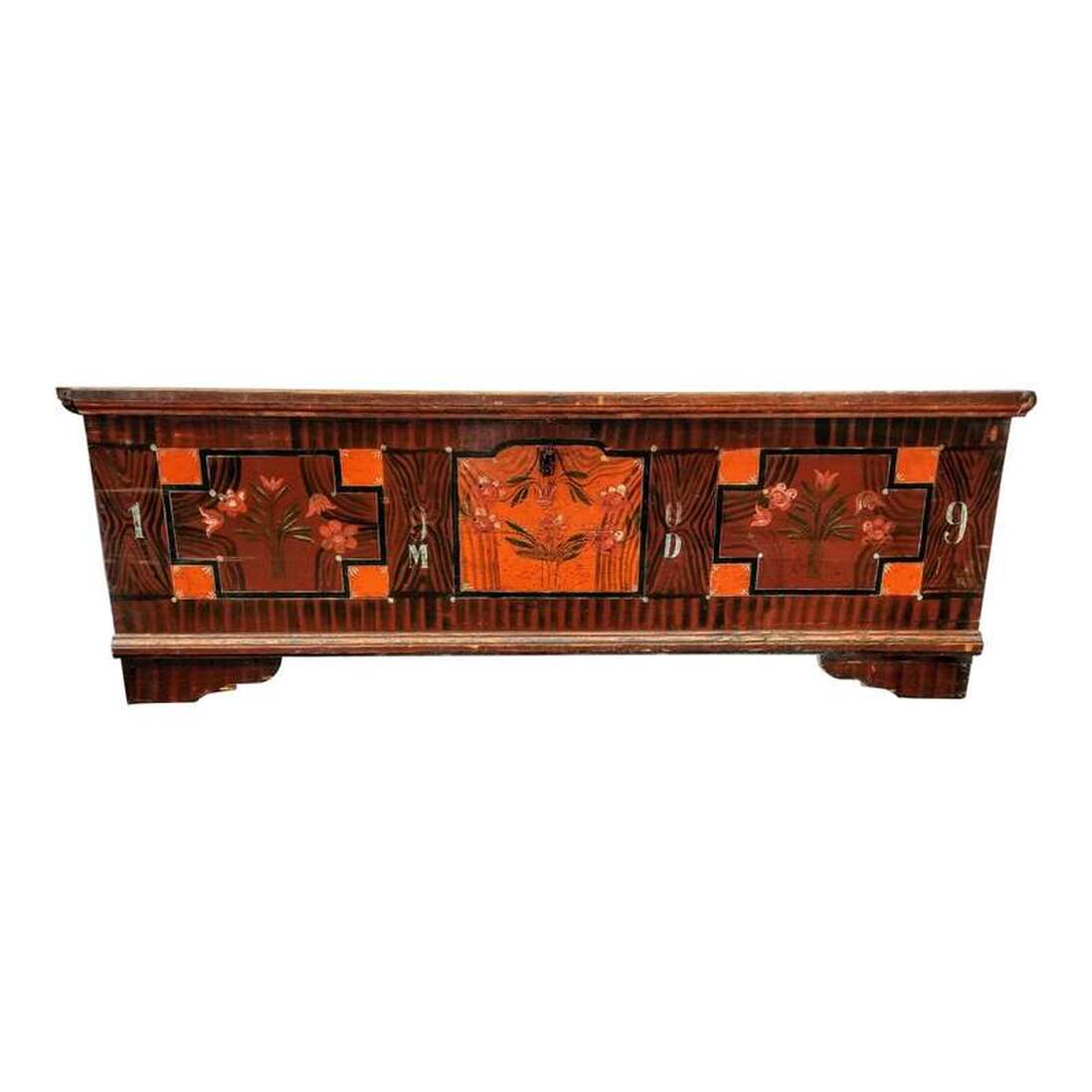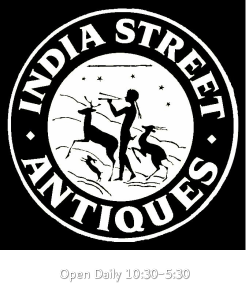Dressers and Chests

Vintage Theatre Trunk
Vintage steamer trunk from magician's estate.
Traveling trunk has the word "theatre" painted on both ends and a name starting with "Lewis" on the lid, but we cannot make out the rest of the name.
Also painted on the lower right corner of the lid appears to be the word "staff".
Vintage radio station labels have been applied to the top and front of the trunk, perhaps from radio appearances as the troupe traveled their performance route?
The outer finish is alligatored.
The edges and corners are supported by iron hardware. This trunk is built well and is very sturdy.
The front lock hardware is brass and the trunk does lock and comes with the key on an old blue satin ribbon.
The interior is fitted with a removeable tray with three compartments and what is possibly a makeup box that pulls out from the tray. The edges of the tray are supported with copper strips.
The bottom is fitted with four compartments.
The interior elements are painted green with red trim.
The black leather handles on either side were likely replaced.
SIZE: (Not Including handles): 30.75" wide 13" deep 16.5" high
SOLD
Click on the image above to learn more and to view further photos.

Arcón | Carved Oak | Spain | 17th century
Spanish Renaissance period carved oak arcón with iron and brass mounts.
Antique chest from the 1600s is peg constructed of oak wood.
The lid is solid burl figured oak attached to the carcass with wrought iron diamond tipped strap hinges on the underside.
The front panels show carvings of foliated spandrels over arcading arches cupping floral fans. The arches stand on plinth bases.
The original key fits through a chased brass escutcheon sporting a foliated scroll and lozenge motif.
The carcass rests upon four turned oak bun feet.
The side panels are fitted with twisted wrought iron bail handles. The handles indicate this may have been built for use as a traveling trunk or campaign chest.
The back is of a plain board.
The interior is fitted with a hinged-lid box on the top left side for storage of candles and other small objects.
Outer surfaces are finished with hand rubbed paste wax.
Click on the above image to learn more and to view further photos.
38ʺW × 21ʺD × 19.5ʺH
SOLD

James Shoolbred & Co. | London, England | Arts & Crafts Oak Chest of Drawers | Owen William Davis Design
1874-1876
Original Medieval-influenced English Arts & Crafts oak chest of five drawers based on an 1874-1876 creation by Owen William Davis for James Shoolbred & Co.
Chest has two small side-by-side drawers at top followed by three full-length drawers below. The drawers are accessed by tugging on the copper-plated Arts & Crafts pulls.
Dresser is constructed with quarter sawn ("tiger") oak.
The slat back indicates an 1870s construction.
Keys are provided for the drawer secure lever brass locks.
42ʺW × 21ʺD × 42ʺH
2395
Click on the image above to learn more about James Schoolbred and Owen William Davis and to view further photos.

1909 Magyar Folk Art Trunk | Austro-Hungarian Mintak Pattern Dower / Dowry Tulip Chest
Dower or dowry chest dated "1909" on the front along with the initials "M D". Also called a maiden chest, marriage trunk, or bridal chest.
Chest is a simple painted pine wood with bracket feet.
American versions, created among the German, Swedish, and Dutch communities, of these folk art chests were given to children from their fathers around 14 years of age and were used to carry their belongings. The chest moved with them when they were married, similar to a dowry. They were sometimes used as a table or bench seating. Valuables were kept in them such as frakturs and documents, along with useful items such as candles and blankets. When a husband died, his widow retained the "dower" chest with it's contents.
71.75" wide x 24.25" high x 23.5" deep
SOLD
Click on the image above to learn more and to view further photos.
Read the text below for an introduction to the proliferation of Hungarian folk art and furniture.
The Proliferation of Hungarian Folk Art Style
The Serbians brought with them their style of folkloric painted furniture when they moved northward to the Danube Basin, which was dubbed "Pannonian rural baroque" for the intricate forms, ornamentation, and painting.
By the 17th and 18th centuries carpenters were supplying villages with painted furniture. This period showed a growth of interest among the Magyar in the emboidery and designs of the Serbs and the style of Hungarian folk art was launched.
The Danube Basin welcomed Swabians in the 19th century, who brought with them their styles of design, informing Hungarian folk art style further. Hand painted "old peasant" "village style" pine chests, or trunks, such as the one pictured above, were either commissioned from artisans, bought at fairs, or were shipped from centers well known for rural painted furniture, such as Komarom.
In 1900 Hungary exhibited in the Exposition Universelle in Paris and were ignored amidst the praise for the exhibits from Austria; however, in 1902 Hungary exhibited at the International Exhibition of Decorative Arts in Turin and received positive coverage in the decorative arts journals. The folkloric influences spread to Vienna and throughout the Austro-Hungarian empire, then to the rest of Europe.
By the 17th and 18th centuries carpenters were supplying villages with painted furniture. This period showed a growth of interest among the Magyar in the emboidery and designs of the Serbs and the style of Hungarian folk art was launched.
The Danube Basin welcomed Swabians in the 19th century, who brought with them their styles of design, informing Hungarian folk art style further. Hand painted "old peasant" "village style" pine chests, or trunks, such as the one pictured above, were either commissioned from artisans, bought at fairs, or were shipped from centers well known for rural painted furniture, such as Komarom.
In 1900 Hungary exhibited in the Exposition Universelle in Paris and were ignored amidst the praise for the exhibits from Austria; however, in 1902 Hungary exhibited at the International Exhibition of Decorative Arts in Turin and received positive coverage in the decorative arts journals. The folkloric influences spread to Vienna and throughout the Austro-Hungarian empire, then to the rest of Europe.
